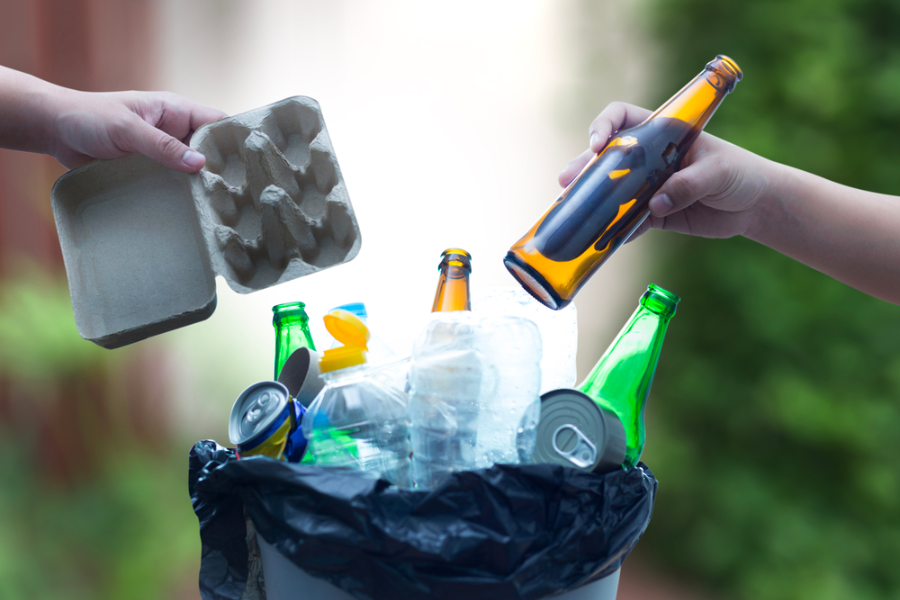
A March 27 webinar featured tips and best practices from recycling experts Chaz Miller and Gretchen Carey. | One Photo/Shutterstock
In recent years, the recycling industry has seen negative media coverage that has not only perpetuated myths but also contributed to public mistrust of collection and recycling – and ultimately could be contributing to lower collection rates.
To help counteract the misinformation, the Maryland Recycling Network presented a March 27 webinar featuring Gretchen Carey, president at MassRecycle, and Chaz Miller of Miller Recycling Associates.
Misinformation about recycling was merely “background noise” to Carey until October 2022, when Greenpeace published a scathing report about the failings of plastic recycling. Soon NPR and The Boston Globe picked up the story and compounded the issue with statements like “not even plastic water bottles are recyclable,” Carey said, calling this “a patent lie.”
Carey and her colleagues were “crushed,” but after overcoming her initial anger, she reached out to NPR and the Globe to rebut the story. She also tried to get other local publications to publish her written response to the negative coverage but was rebuffed.
Seeing that these efforts weren’t going far, MassRecycle invited members of the media and the general public on MRF tours at several sites in Massachusetts and Connecticut. Providing real-time evidence of recycling infrastructure helped industry outsiders step out of the echo chamber and hear a contrasting perspective, Carey said in the webinar. “You can talk the game, but them seeing for themselves is the important part,” she explained.
During the tours, the public attendees learned that throwing away recyclables deprives the community of valuable commodities, she said, and that state guidelines restrict what can be put in the landfill.
Carey added that the tours brought home the message by explaining that recycled materials need a consistent end market to justify collection and processing. For example, Ardagh closed its glass bottling facility in Massachusetts in 2018. The closure eliminated a key end market for recycled glass and caused collector Strategic Materials to stop taking local recovered glass. Local MRFs subsequently lost that revenue stream.
When residents don’t trust recycling infrastructure, they put fewer items in their curbside bins, and ultimately paper, metals and glass wind up as collateral damage, Miller said. So it’s vital to make sure the public knows where their recyclables and that end markets exist to use these materials.
‘Lean into the truth’
Among Carey’s best practices for engaging with the public and the media to counteract misinformation was to “lean into the truth.” She warned against sugarcoating negative truths, which audiences see through easily. For example, admitting that bad actors exist but emphasizing that the majority of people are trying to do the right thing can help encourage public trust in the message.
Miller emphasized this point as well: “Yes, recycling has always been plagued with unscrupulous operators who will slip contaminants to get the product moving. But they’re not the norm, they’re the exception.”
It’s also important to acknowledge that recycling businesses are just that – businesses, intended to make money more than to save the planet, Carey said. The message that recycled materials are valuable commodities that benefit the community and sustain local businesses resonates with people, she added.
But be clear about what gets thrown away – beyond rigid containers, MRFs receive many other items that “we didn’t ask for and don’t want,” such as plastic bags, half-full yogurt containers that are too heavy to be segregated properly with an optical sorter and fully unsuitable items such as bowling balls and propane tanks.
Because recycling programs focus on rigid plastic containers, which represent only 17% of the plastics the U.S. generates in a year, “no wonder the (overall) plastics recycling rate is 8.7%,” Miller said.
Even official data is confusing and can be outdated. For instance, the U.S. EPA’s most recent recycling rate is from 2018 and is anywhere from 32.1% to 38.2%, depending on what exactly is being measured, Miller said. He added that media coverage tends to cite the lowest number, and journalists could use help in providing context.
Finally, when speaking with the media, keep your comments succinct, and funny if possible, Carey said. And embrace emotion about recycling – both yours and theirs, she said. When building relationships, select reputable journalists by reading their previous coverage: Is it fair or overly biased? And be proactive by contacting them with story ideas and acting as a resource for the journalist, able to provide background information or verify information even if you don’t want to be quoted directly.
But be careful not to tell them what to think, she said. Provide the information and let them draw their own conclusions.
Although recycling is far from a fraudulent enterprise, the public and even brand owners often underestimate how challenging the industry is, Miller said. And while recycling rates are not stagnant, tonnage and percentage gains are slowing down with increasingly lightweight materials, he said.
It’s also important for the public to understand that plastics are uniquely difficult to recycle, Miller said, due to having far more product types and colors than paper or metals.
“The bar we have set is so low it’s going to be very hard moving that plastic recycling up,” he said.

